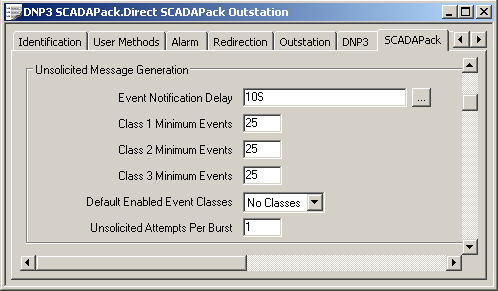NOTE: The fields within the Unsolicited Message Generation section of the tab apply to unsolicited messages that the outstation sends to any DNP3 master. If an outstation is to send unsolicited messages, in addition to the fields in this section, you also have to configure the properties within the Master 1 Configuration section of the tab and, if applicable, the relevant properties on the Multiple Masters tab.
Use the fields within the Unsolicited Message Generation section of the SCADAPack tab to specify the conditions that have to be met in order for the outstation to generate an unsolicited message.

- Event Notification Delay—Specify the delay between the outstation detecting a ‘Send Unsolicited’ condition, and the contents of the Event Buffer being sent as an unsolicited message.
Enter the required delay in the OPC Time Format, for example 10S for a 10-second delay.
The SCADAPack E outstation will send an unsolicited message if:
- Its Event Buffer contains more than the specified number of one of the Event Classes
- The generation of a particular event causes the outstation to transmit its buffered events to ClearSCADA in an unsolicited message (see Specify Whether a Class n Event Triggers an Unsolicited Message).
- Class 1 Minimum Events—Specify the minimum number of Class 1 events that have to be stored in the SCADAPack E outstation’s internal Event Buffer, before the outstation attempts to send an unsolicited message.
- Class 2 Minimum Events—Specify the minimum number of Class 2 events that have to be stored in the SCADAPack E outstation’s internal Event Buffer, before the outstation attempts to send an unsolicited message.
- Class 3 Minimum Events—Specify the minimum number of Class 3 events that have to be stored in the SCADAPack E outstation’s internal Event Buffer, before the outstation attempts to send an unsolicited message.
- Default Enabled Event Classes—Use the combo box to specify the event classes that are enabled for unsolicited event generation by default (for example when the outstation restarts). This option is primarily used for compatibility with older DNP3 masters.
After initial communication with the outstation, ClearSCADA will override the Default Enabled Event Classes (this action does not change the value of this property). For further information, see Enable Unsolicited Message Generation in the ClearSCADA Guide to the DNP3 Driver.
- Unsolicited Attempts Per Burst—Specify the maximum number of times that the outstation attempts to send an unsolicited message if it does not receive a response from the DNP3 master. If the DNP3 master has still not responded following the final attempt, the outstation waits for the DNP3 master’s Quiet Time Delay to elapse before attempting to resend the unsolicited event message.
The local ClearSCADA server’s Quiet Time Delay is specified using the relevant field within the Master 1 Configuration section of the tab (see Configure the Unsolicited Message Properties that are Specific to a Particular DNP3 Master). The Quiet Time Delay of any additional DNP3 masters is specified using the relevant field(s) on the Multiple Masters tab (see Specify Whether an Outstation Communicates with Multiple DNP3 Masters).
NOTE: When a SCADAPack E outstation generates an unsolicited message, it sends the contents of the Event Buffer to the ClearSCADA server in a single DNP3 fragment. If there are too many events to send in a single DNP3 fragment, the outstation will indicate that more events are available, by setting the appropriate DNP3 IIN bit in the unsolicited message.